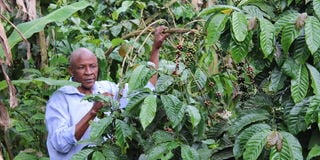Prime
Ssebowa has reaped big from coffee for 35 years

John Sebbowa tends to his coffee. The farmer has planted clonal coffee on seven acres. PHOTO/Roland D. Nasasira
What you need to know:
Coffee farming is a lucrative industry that is raking in billions of shillings every year. However, farmers cannot enjoy the profitability of the agribusiness if they do not understand the conditions of their soil. John Sebbowa says with the right soil, it’s easy to solve the challenges of nutrient deficiency and evade several diseases. On his farm, he uses animal waste such as cow dung to fertilise his coffee.
Farmers may not have qualified to benefit from the government’s donation of Shs100,000 given out to vulnerable households as subsidy during the ongoing Covid-19 induced lockdown, but they are among the categories of people severely hit by the pandemic.
In their trucks and pick-ups the farmers can drive across districts to get farm inputs and to transport their products to far off towns and markets. However their general complaint nowadays is that the prices for their commodities have dropped so low that they don’t make profits any more.
Low prices
When I meet John Sebbowa at his home at Kateera Village, Mirambi Parish, Kibinge Sub-county in Bukomansimbi District, he is walking around his coffee gardens looking out for coffee trees with ripe seeds to harvest. Coffee growing has been his livelihood since 1986.
With a 35-year coffee growing experience under his belt, Ssebowa recalls starting out with one acre. At the time, he would harvest approximately three to five bags of coffee per acre. Then, one kilogramme of coffee cost between Shs300 and Shs400 while a 100 kilogramme bag went for Shs50,000 and Shs60,000.
“When more responsibilities of looking after my family and educating children increased, I would add half an acre of land to the existing garden every planting season and sometimes in a year to meet family needs. I was limited from expanding the garden because of land shortage,” Ssebowa recalls.
This, however, was in addition to grazing cattle, doing piggery and poultry from which he obtained animal fertilisers to use on his garden.
Expansion
Over the years, Ssebowa’s yields have not only increased but the prices of coffee have also not been left behind. In a good season, Ssebowa says he harvests more than 30 bags of coffee on one acre.
“When the season is bad, I get only 15 bags. There are also times when the hot temperatures are severe and I do not harvest a single bag from one acre. This is where I and other coffee farmers in the area need support to boost our yields especially during dry seasons,” Ssebowa cries out.
With two harvesting seasons in a year coming in June and December, Ssebowa says the main market source for his and other farmer’s coffee is Kibinge Coffee Farmers’ Cooperative Society Limited that buys coffee from different farmers at Shs4,200 per kilogramme. Before the cooperative came in to buy coffee from farmers, Ssebowa says he and other farmers often sold the coffee to different middlemen and brokers who bought a kilogramme at a paltry Shs1,800.
Farming practices
Ssebowa advises that if you are to harvest a number of kilogrammes from one coffee tree, you have to carry out a lot of weeding. You also have to apply organic animal fertilisers such as cow dung to improve yields. Secondly, the distance from one coffee tree to another ought to be between 10 and 12 feet. This allows for proper spacing to allow one plant absorb and improve fertiliser uptake from the ground. This means that on one acre can accommodate about 450 trees of coffee.
Lately, Ssebowa grows clonal coffee on seven acres. In one season, he is able to earn about Shs7m from one acre. However, the bags harvested from one acre is determined by the weather condition. Clonal coffee is the dominant type grown in Kibinge.
Challenges
Much as he gets fertilisers from animals, Ssebowa says it is challenging to sustain because a change in weather also affects animals and this also affects fertilizer production. This means he has to think of other fertiliser options if he is to realise high coffee yields.
“The gardens are also affected by hot weather. If we had irrigation schemes to use on the farms, output would be high. The hot weather is normally existent for between three to four months. Some of the coffee produced by some farmers is of low quality because of poor post-harvest handling practices. Some farmers are forced to dry their coffee on the floor which affects the quality of the dry beans,” Ssebowa says.
There’s also a challenge of pests that eat the coffee leaves. This, according to Ssebowa, dries the coffee beans before it is due for harvesting.
Advice to coffee farmers
Ssebowa concludes by advising farmers to consider coffee as an important crop. There is hope for better coffee prices and market but that it is dependent on the kind of care for the coffee on and off the farm.
David Lukwata, the general manager of Kibinge Coffee Farmers’ Cooperative Society Limited says the cooperative has registered 2,300 coffee farmers at Kibinge Sub-county in Bukomansimbi District. However, most of these are registered in groups of 30 farmers. If farmers register as a group, they are considered one person.
“Once farmers become members, they benefit from the premium market we offer for farm profit. They are also trained on the best agricultural practices as well as access to extension services. We have a savings and credit cooperative (SACCO) where we offer financial services to farmers,” Mr Lukwata says.
Coffee farmers are also provided with farm inputs on credit, including seedlings, as well as prevailing market information. They also get dividends at the end of the year because when farmers join the cooperative, they become its owners beyond just being members.




